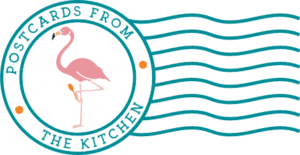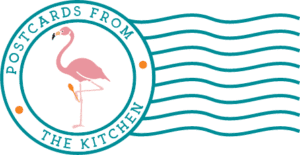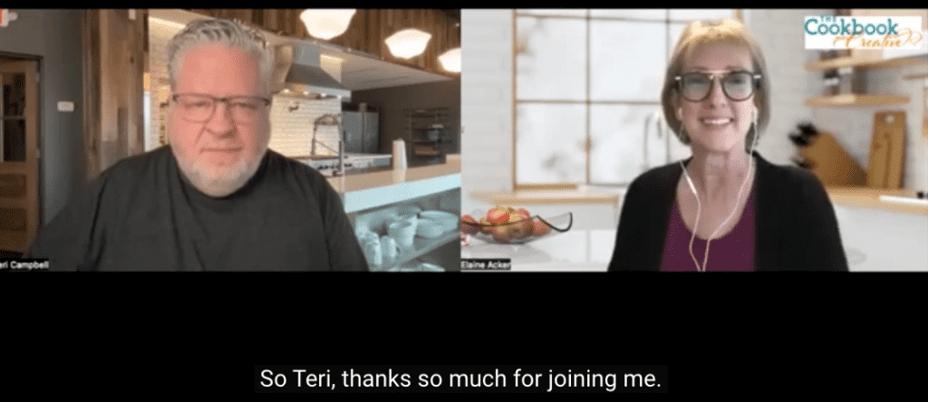Last week, I had a chance to chat with Teri Campbell. He’s a Cincinnati-based food photographer, and he’s taking full advantage of the advances in artificial intelligence (AI) to produce exciting new images. He’s also a marketing pro, and I couldn’t wait to hear about his work!
HEREAn Interview with Food Photographer Teri Campbell
\n\n- \n
Elaine: Let’s walk through your photography journey. Tell me about becoming a food photographer.
I got a camera for my 16th birthday, and I took some classes in high school, built a dark room in my parents’ basement, and was just smitten with it. I went to school for photography and started working at P&G (Procter and Gamble) right out of school as a contractor in their photography department. I really loved the collaboration of working with the other photographers at P&G, and all the things we got to do. We did tons and tons of food, and after about four years there and various assisting jobs, I decided that I’d hang my own shingle.
But once you go out on your own, you’re really on an island. Everybody stops talking to you because now you’re competition, and it just was a very strange relationship. This was 1988, so before it was before the word “foodie” even existed. And, at that time, photographers didn’t like shooting food. It was laborious, it took a long time, it was highly specialized…
So I thought, even if I’m the worst photographer shooting food, I’m one of five instead of one of 40. So, it just felt like a place I wanted to go. Plus, like I said, it gave me the opportunity to collaborate with food stylists, which was what I loved. So, for me, it was a business decision and being able to work with other people.
I am not your typical foodie. I’m more of a meat-and-potatoes kind of guy. But I love the work, and I love photography, I love lighting food, so that’s the part that really inspires me.
Elaine: Talk to me about how you started getting into AI and how that’s influencing what you’re doing moving forward.
We do commercial photography for packaging or for point of purchase. So, menus, the grocery store, the things you buy every day, all of that photography. So for us, that’s kind of the bread and butter daily stuff that we do and the stuff that I really enjoy doing.
The AI I’ve just kind of discovered in the last few months. My immediate thoughts were, how can I use this in the photography work that I’m already doing? And one of the projects we’d just done last summer involved shooting a kitchen behind a model. We had a stock kitchen photograph, and I thought, what if I could have created that in AI? Could I have created a different kind of kitchen? Could I have adjusted it more? I remember there were conversations at some point – maybe they wanted a kitchen that had a holiday theme – and I thought, could I add a holiday theme pretty easily with the AI? And so those were my initial thoughts on how to use it. And then it just kept morphing, and I started finding out that I could create an entire shot if I wanted to. It doesn’t work for everything. It has a lot of limitations, but for me, it’s been backgrounds, it’s been elements, it’s been things to add to shots, it’s been inspiration, and color theory. You can kind of try a bunch of things – build a set, see what the colors work, and how the props could be. It’s kind of invaded almost every aspect of what I’m doing right now.
Elaine: After you and I connected on LinkedIn, I became addicted to all the AI images you’re posting on LinkedIn. And what really fascinated me was that it seems like there is so much potential to create a really unique cookbook.
For example, we’re going to work with a very high-end cabinet manufacturer next month, and we’re starting a new custom cookbook. And I’m looking at what they do – it’s this very elevated approach to kitchens – and thinking it would be super interesting to see if there were ways to incorporate some of the AI elements into some of the photos they’re going to shoot for their cookbook. So I’ve got that in the back of my mind as we talk, and just thinking about how to take all the cookbook images up a notch because this is just fascinating.
Yeah, the kitchens I’ve been able to create are really fun. I give it prompts, like, “industrial, stainless steel kitchen,” and then it returns that, but it also returns a little bit more. For example, I never would’ve thought that the upper cabinets were open metal shelves packed full of stuff, but that looks really cool. It’s the discovery process for me, and that’s what I love.
Also, I’m not a photographer that envisions the shot and then goes to create it. That doesn’t usually work for me. What works for me is knowing it when I see it and finding a spark. And that’s where AI is so perfect because you can start down a road, and then there’s a spark, and you’re like, “Ah, that. Let’s do that, let’s do more of that.”
Elaine: Who do you work with most often? What kinds of clients are ideal for you?
We do a lot of fast food, there always seems to be a QSR (Quick Service Restaurant) somewhere in our client roster. We do a lot of work with KFC, Jimmy Johns, and Baskin Robbins. We also do stuff for Maker’s Mark because we do beverage stuff as well. And then there’s a lot of packaging for Kraft, Heinz, Kellogg’s, Hershey’s, that kind of stuff.
Elaine: I love it. Have you done any cookbook projects up to this point?
One. but it was a promotional project that we did years ago now, and it was called a “Small Fries Kids Cookbook.”
We partnered with an agency that did the design, and a food stylist worked with us on it. We asked kids to send us recipes, and then we did a photograph for every recipe and included a picture of the child. And we donated the proceeds to the Cincinnati Children’s Hospital.
Elaine: From a marketing perspective, you’re using not just the AI, but the photography as a whole. I think sometimes people overlook the power of the image that is drawing people in. Getting the buyer’s attention. What’s your take on how that influences marketing?
Obviously I think photography has a lot of power. One of the ways I like to describe it is that if you took a picture of a package or even of a parked car, there could be a lot of photographs that were okay, some would be exceptional, and some would be really hideous.
There would be a lot that were acceptable, and they’re fine, they work for what you need. With food, either makes you hungry, or it doesn’t. It’s a very thin line, and you really have to make sure that the food is appetizing, pulling people in and making them want to purchase that product or buy that product on the menu board.
I definitely think it has a huge impact. And I think where the AI will have, you know, the most immediate impact is in content marketing. Because we’re trying to create these images that are going to live on Facebook for a few days. You don’t want to invest a lot of money because it’s not going to be seen for that long. So, AI allows us to create things at a much lower cost. I can create a whole kitchen scene, strip the product into it, and that’s fine. But if I had to build a whole kitchen, light it, put the product in it, you know that’s too much expense for something that’s going to be used in social.
So I see it as content marketing. It could be huge. If I were publishing a magazine and I just needed a photograph of pumpkin pie for Thanksgiving, and I didn’t need Mary’s pumpkin pie, why can’t I do that with AI now? So, it’s going to creep in. It’s going to change things. And I think it’s going to change things for the better. This is just another tool for us all to use, and for us to explore and build upon. Now we can do so much more.
Elaine: One of the reasons I wanted to ask you about that was because my husband was a photographer and photo editor for Texas Parks and Wildlife Magazine. And I was a contractor there, working in advertising sales and contributing stories as a writer. He was all about the images, and I was all about the words.
But I have come to appreciate the images and how they really invite people into the story. By the way, it was your image of the camera that finally got me to, that I was like ah, I really do need to talk to him. So, I loved it.
Teri: I gave the AI the prompt – “If AI were a camera, what would it look like?”
Elaine: I loved that image.
If you want to see it, go to Teri’s LinkedIn page.
Alright, so let’s talk a little bit more about you. You said you’re a meat and potatoes kind of guy, Any food experiences, or favorite meals… anything like that that you can share?
Teri: One of my favorite meals was in Italy. We were in a small town where the market comes around just once a week; you know, where they bring in the small, Italian food trucks. And so it was market day, and I remember we went down there, and we just got a rotisserie chicken, Parmesan cheese, and bread. And it was like the best meal ever. It was just so amazing, and so fresh, and so good, and you know, that just really captivated me. I mean, that’s been 14 years ago, I still remember it. Like, I just want to sit down and have that meal again.
Another one also has an Italian connection. There’s a restaurant in Cincinnati called Sotto https://www.sottocincinnati.com/, where my wife and I usually go to on our anniversary. And it’s really incredible. We really love the ambiance there, and the food of course is delicious.
Elaine: I love the food memories.
Teri: They’re so strong. We get that feeling all over again. Even if we’re not standing in Italy at that moment.
My mom used to always make me chicken and dumplings on my birthday. I’ve tried to recreate it, but she’s been gone a few years now, and I just can’t get that magic back.
Elaine: I know it’s hard. That was one of the reasons we started The Cookbook Creative. We just wanted to capture family recipes.
Teri: I don’t have those recipes. I have bits and pieces I find, you know, going through some stuff, but never the full thing. I wish I had done that before we were at this stage.
Elaine: As you evolve as a photographer are there any big goals for you coming up?
Teri: Right now, it’s just exploring the AI, having some fun with that and trying to see where this takes me. It’s been a renaissance in a lot of ways for me, because I felt like, you know, we do a lot of fun stuff, we have a lot of great projects; but I was looking for kind of the next challenge, and where I might go from here.
And the AI, for now, has provided that spark. It’s gotten me excited in a way that I haven’t been, since… I think since I got that first camera when I was 16. It’s opened up so many possibilities.
After I got to the point where I was doing mostly food, and kind of the scales tipped and everybody said, “Oh, you’re the food guy,” it was great, because I got really wonderful food assignments. But nobody thought I could do anything else. But I loved shooting portraits.
With AI, I can explore people again. I can explore shooting architecture, or whatever it is. I can do so many things. And I can just try it, and it’s doesn’t cost me anything really, to try an idea, or see where that goes.
Elaine: That’s fascinating. Real quick, back to Cincinnati ,since that’s where you are… Is there anything in Cincinnati that, is there a food that Cincinnati is known for?
Teri: That’s an easy one. Cincinnati chili. Cincinnati has more chili parlors per capita, than anywhere else in the United States, including Texas.
Elaine (laughing): Them’s fighting words!
Teri: You’re really going to hate us if you come here because it’s not Texas style chili. It is Greek chili, so it’s very thin, and it’s served over spaghetti. So you would get it over spaghetti with cheddar cheese on top, that would be called a three-way. Or you would get it over a hotdog in a bun with cheese on top, and that’s a coney. Some people would add onions to that. You can also add onions and beans to the three-way.
But Cincinnati style chili is definitely what we’re known for; that would be the number one thing. t’s a fun, Midwestern food town.
Cincinnati’s also the branding capital of the world. P&G is based here and they pretty much invented brand marketing. And so some of the largest offices for some of the big agencies are based here in Cincinnati. It’s a really great mecca just to be in the advertising business.
And you also have so many restaurants that are located in the Midwest, you know, with Wendy’s, and KFC, and Long John Silvers, and Maker’s Mark just to the South; Steak ‘n Shake in Indianapolis; Donatos Pizza in Columbus.
Elaine: So many things I never knew about Cincinnati!
Teri: It’s great little town, I mean, I was born and raised here, so I’m biased. But I love it, and like I said, it’s been great for my business and what I’ve wanted to do.
Elaine: I have appreciated every minute of talking to you. If people want to work with you, how do they get in touch with you?
Teri: The easiest way is probably just on my website – Teristudios.com. I’m also on Instagram and LinkedIn.
I would like to say that I know there’s been a lot of talk lately about AI, and there’s people on both sides of this issue. I had an artist friend who was very concerned. But we had some conversations and he’s actually using it now to create ideas for future paintings.
So, I think AI is really just another tool. It’s just like Photoshop was; like auto-focus was. But you still need a photographer. And you’ll still need a photographer with AI, because we’re in the idea business. People can buy the same cameras and lights we have now, but they can’t do what we do. And I think the same is true with AI. Sure, a lot of people will have more tools than they had before; but I think those of us who are in the field, and understand how to use it, and are creative, will have superpowers.
I just hope people can explore, try it out, see what it’s like, at least be aware of what it can do. The genie’s out of the bottle. We really can’t stop it now. So, let’s just see how we can use this. It’s given me new life and I can’t be more excited about it.
Elaine: I’m going to echo what you said from the writing side; because I am one of those who has resisted trying the new AI generated copy. It’s the same mindset. “Oh dear, they’re going to replace all the writers and they won’t need us anymore.” And you’re right, it’s just another tool in the toolbox. And if it makes it possible for small business owners, to get started with some new content and use that to edit more of their own personality into it – to put their own spin on it – that can be a valuable tool. So I just wanted to echo that. It’s here. How can we leverage it and make it work for us.



